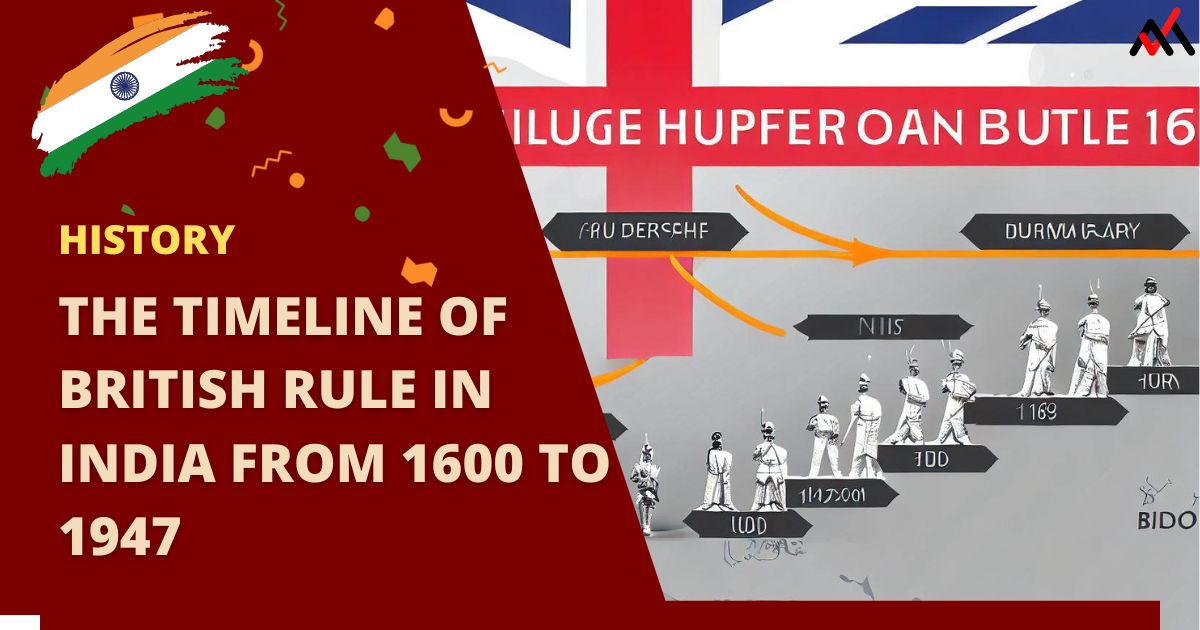India’s history is a tapestry woven with threads of diverse cultures, empires, and rulers. One of the most significant chapters in this rich narrative is the era of British rule. Spanning nearly three centuries, from 1600 to 1947, the British Raj left an indelible mark on the subcontinent.
The history of British rule in India is a tale of conquest, colonization, and ultimately, a struggle for independence that led to the birth of the world’s largest democracy. This article takes you through a chronological journey of the British presence in India from 1600 to 1947, highlighting key events, milestones, and the evolution of India’s fight for freedom.
Timeline of History
In this carefully crafted timeline, we delve into pivotal events that not only chronicle the course of colonial dominance but also illuminate the evolution of India’s quest for freedom.
Each entry on this timeline represents a milestone, a turning point that shaped the social, political, and cultural landscape of the Indian subcontinent.
As we journey through these significant years, we invite you to explore the impact of each event, reflect on the struggles endured, and appreciate the indomitable spirit that ultimately led to the dawn of a new era:
| Year | Event | Importance and Impact | Key Takeaways for Modern India |
|---|---|---|---|
| 1600 | The Birth of the East India Company (EIC) | Establishment of the EIC, a precursor to British colonial presence. | Foundation of British influence. |
| 1615 | The EIC’s Acquisition of Bombay | First territorial foothold, setting the stage for future British control. | Emergence of British territorial ambitions. |
| 1748 | The Anglo-French War in India | European power struggles impacting India’s geopolitical landscape. | Influence of global conflicts on colonialism. |
| 1757 | The Battle of Plassey | EIC’s political ascendancy, reshaping Indian governance and economy. | The emergence of British territorial ambitions. |
| 1792 | EIC’s Victories Over Marathas and Tippu Sultan | Expanding British territorial control and influence in India. | Strengthening British dominion. |
| 1806 | The Vellore Mutiny | The catalyst for direct British rule. | Prelude to future Indian uprisings. |
| 1857 | The Indian Mutiny and the First War of Independence | The End of Mogul Rule and the Dawn of the British Raj | Birth of India’s struggle for independence. |
| 1858 | The transition from Mogul rule to direct British Crown governance. | Early signs of resistance against British rule, prompted policy changes. | Establishment of formal British Raj. |
| 1869 | The Birth of Mahatma Gandhi | Birth of a transformative leader advocating nonviolent resistance. | Gandhi’s influence on India’s freedom movement. |
| 1877 | Queen Victoria’s Proclamation as Empress of India | Symbolic elevation of British authority over the Indian subcontinent. | Reinforcement of British imperial control. |
| 1885 | The Formation of the Indian National Congress | Birth of a political platform advocating Indian representation. | India’s wartime contributions paved the way for post-war self-rule. |
| 1897 | Queen Victoria’s Diamond Jubilee | Celebration of British imperial power, fostering Indian national pride. | Inspiration for India’s pursuit of autonomy. |
| 1914 | World War I and its Impact | India’s role in a global conflict, shaping nationalist aspirations. | Brutal repression sparked anti-colonial fervor and resistance. |
| India’s role in shaping its destiny. | The Jallianwala Bagh Massacre and the Rowlatt Acts | Gandhi’s iconic protest against the unjust British salt tax ignited change. | Galvanization of Indian opposition to British rule. |
| 1930 | The Salt March and Civil Disobedience | Mass calling for immediate British withdrawal, intensifying independence bid. | Example of nonviolent resistance’s power. |
| 1939 | World War II and India’s Quest for Freedom | India’s wartime contributions paved the way for post-war self-rule. | India’s wartime contributions paved the way for post-war self-rule. |
| 1942 | The Quit India Movement | India’s wartime contributions, paved the way for post-war self-rule. | Stepping stone toward India’s sovereignty. |
| 1947 | The Dawn of a New Era | Attainment of independence, partition, and emergence of modern India. | Birth of sovereign India and Pakistan. |
Detailed Historical Narrative
1600 – The Birth of the East India Company (EIC): The year 1600 marked the establishment of the East India Company, an English trading venture chartered by Queen Elizabeth I.
Initially aimed at trade with the East, the EIC would eventually become a vehicle for colonization and governance. The archives of the British Library hold valuable records showcasing the EIC’s transition from a commercial entity to a powerful political force in India.
1615 – The EIC’s Acquisition of Bombay: The acquisition of Bombay in 1668, a part of Catherine of Braganza’s dowry upon her marriage to Charles II, laid the foundation for British territorial expansion.
The National Archives of India house documents that trace the administrative changes brought about by this transfer of sovereignty.
1748 – The Anglo-French War in India: The 18th-century conflict between the British and French in India, known as the Carnatic Wars, was a contest for supremacy that shaped colonial ambitions.
“The French in India: From Diamond Traders to Papal Envoys” by George Bruce Malleson offers insights into the European power dynamics during this period.
1757 – The Battle of Plassey: The Battle of Plassey in 1757 saw the victory of Robert Clive’s forces over Siraj-ud-Daulah, the Nawab of Bengal.
“Clive: The Life and Death of a British Emperor” by Robert Harvey delves into the life of Clive and his role in the battle, shedding light on its far-reaching implications.
1792 – EIC’s Victories Over Marathas and Tippu Sultan: The EIC’s victories over the Marathas and Tippu Sultan expanded British territorial control.
“The Marathas, 1600-1818” by Stewart Gordon provides a comprehensive account of Maratha history and their encounters with British forces.
1806 – The Vellore Mutiny: The Vellore Mutiny of 1806, sparked by cultural and religious concerns, was a precursor to broader unrest.
“The Vellore Mutiny” by Indian sepoys (Indian troops employed by the British) at Vellore (now in Tamil Nadu state) offers an insightful examination of the mutiny’s origins, its participants, and its aftermath.
1857 – The Indian Mutiny and the First War of Independence: William Dalrymple’s “The Last Mughal” provides a detailed narrative of the 1857 uprising, exploring the social, cultural, and political factors that contributed to this watershed event in Indian history.
1858 – The End of Mogul Rule and the Dawn of British Raj: The transformation from the rule of the Mughal emperors to direct British governance is expertly chronicled in “The Fall of the Moghul Empire of Hindustan” by H.G. Keene, shedding light on the complex socio-political changes of the time.
1869 – The Birth of Mahatma Gandhi: Gandhi’s life and philosophy are intimately revealed in “My Experiments with Truth.” This autobiography traces Gandhi’s journey from his early days in Porbandar to his emergence as the guiding light of India’s struggle for independence.
1877 – Queen Victoria’s Proclamation as Empress of India: The proclamation of Queen Victoria as Empress of India in 1877 was a pivotal moment, highlighting the imperial aspirations of the British monarchy.
“Victoria & Abdul: The True Story of the Queen’s Closest Confidant” by Shrabani Basu provides insights into Queen Victoria’s relationship with India.
1885 – The Formation of the Indian National Congress: The foundation of the Indian National Congress in 1885 marked the formal beginning of India’s organized struggle for self-determination.
“The Indian Struggle” by Subhas Chandra Bose offers a firsthand account of the early days of Congress and its evolving role in India’s fight for freedom.
1897 – Queen Victoria’s Diamond Jubilee: The grand celebrations of Queen Victoria’s Diamond Jubilee provided a platform for showcasing British power in India. “Victoria’s Wars: The Rise of Empire” by Saul David examines the global context of the Diamond Jubilee and its significance for British colonial ambitions.
1914 – World War I and its Impact: Jawaharlal Nehru’s “The Discovery of India” reflects on India’s involvement in World War I, exploring the complex intersections between global conflict, Indian contributions, and the burgeoning demands for self-rule.
1919 – The Jallianwala Bagh Massacre and the Rowlatt Acts: “Jallianwala Bagh: Literary Responses in Prose & Poetry” by Rakhshanda Jalil offers a collection of writings that capture the emotional resonance of the Jallianwala Bagh Massacre and the widespread outrage it sparked.
1930 – The Salt March and Civil Disobedience: Gandhi’s “Navajivan” provides a detailed account of the Salt March and his philosophy of nonviolent resistance, showcasing his mastery in mobilizing mass movements against colonial injustices.
1939 – World War II and India’s Quest for Freedom: Yasmin Khan’s “The Raj at War: A People’s History of India’s Second World War” presents a comprehensive analysis of India’s involvement in World War II, including the Quit India Movement and the shifting dynamics of the freedom struggle.
1942 – The Quit India Movement: The Quit India Movement is explored in “Freedom at Midnight” by Larry Collins and Dominique Lapierre, providing a panoramic view of the movement’s leaders, tactics, and impact on the eventual end of British rule.
1947 – The Dawn of a New Era: “The Transfer of Power in India” by V.P. Menon offers a detailed account of the final years of British colonial rule, the Partition of India, and the birth of independent India and Pakistan.
In conclusion, the timeline of British rule in India is a testament to the endurance and resilience of the Indian people. Over nearly 350 years, India transitioned from being a collection of princely states to a unified nation, gaining independence in 1947.
This journey was marked by both cooperation and conflict between the British and Indians, culminating in a historic struggle for self-determination.
Through a meticulous exploration of historical sources, the intricate tapestry of British colonial rule in India is unveiled. Each event, a thread in this intricate weave, reveals the multifaceted nature of India’s struggle for independence.
By referencing these sources, we gain a deeper understanding of the complex socio-political landscape that shaped India’s trajectory, forging a path toward sovereignty and self-determination.
As we look back, we honor the resilience and sacrifices of those who navigated these tumultuous times, ultimately shaping the narrative of modern India. This journey through time reminds us that history is not merely a collection of dates and events; it is the collective story of a people’s aspirations, struggles, and triumphs.


